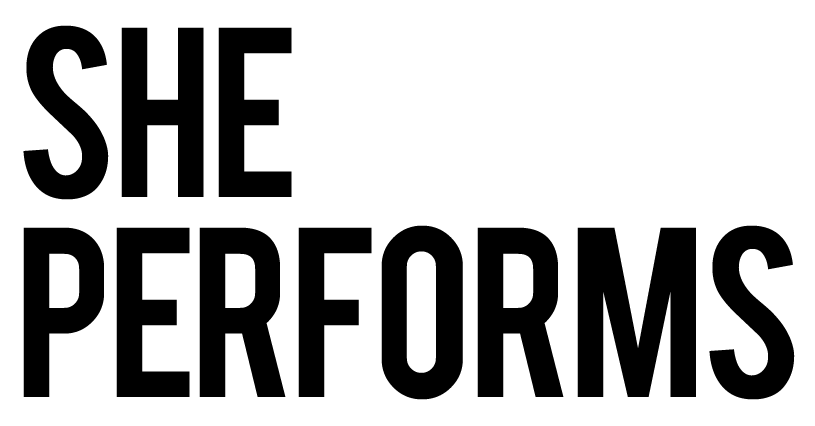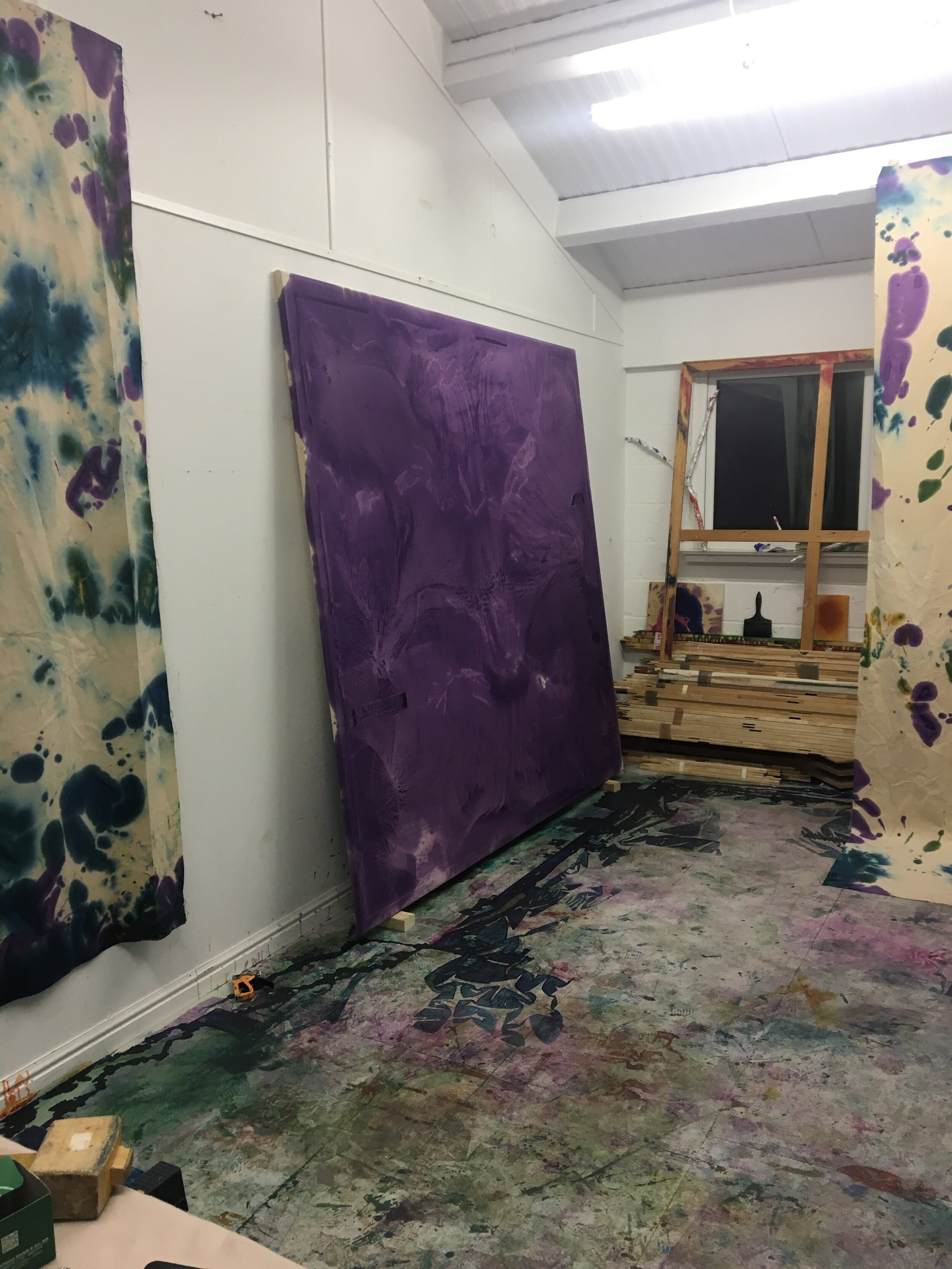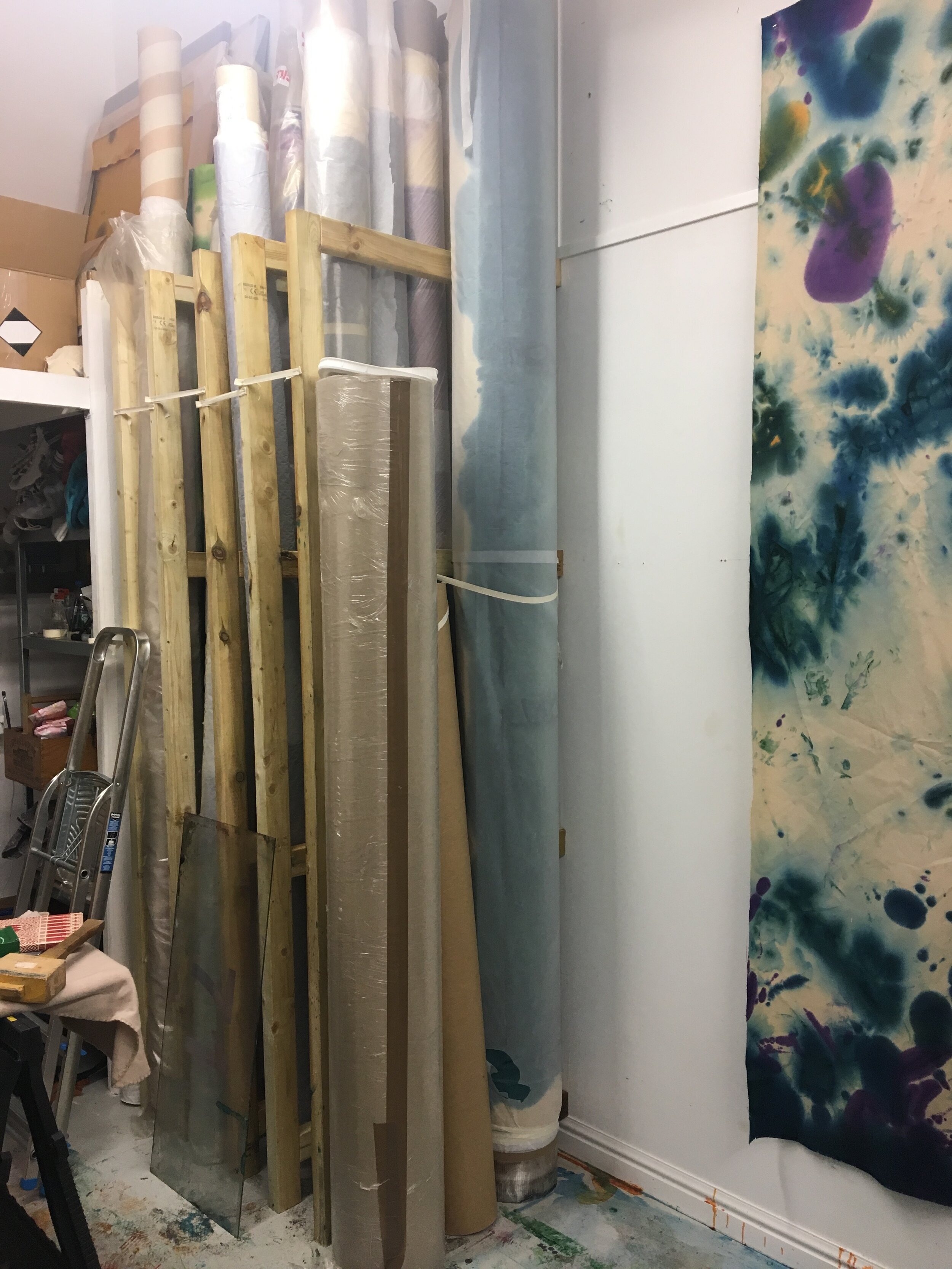Rebecca Guez

I met Rebecca in her studio on the first day that she herself had been back in it after her residency at PADA in Portugal. A lot has changed since January, when she produced the works that I see in her studio. Her studio is very organised - a kindred spirit! Rolls of huge painted canvases stand on a shelf she just recently built herself and older, smaller works are stored away on a platform above the entrance. At some point, Rebecca questions whether she should have brought down and unwrapped more of her paintings. My answer: No. Here’s why: these studio visits are about the artists’ practice. It’s about them as people and as artists. And it is about the space they create their works in. I love the fact that what I (and by proxy, you) see is exactly what Rebecca looked at and thought about on that exact day.
This reversal process, originated by accident. A few years back, Rebecca had worked on a painting for a number of weeks, only to dislike what it looked like. It was around that time that she also lost her former studio, so she brought these paintings home, where they could continue to be worked on and stored for a while.
Eventually, deciding the painting was unsalvageable (subjectively, but we have to believe her due to lack of proof that it wasn’t) and so not to waste the material, she intended to flip the canvas over, to begin again on the back side. When she flipped it, she was stunned by how amazing the back of this painting was. Ever since that original accident, her work has become focused on getting painting ‘wrong and reversed’. I can see bar marks from the stretcher, which the fabric touched because it intentionally wasn’t stretched well. Fabric is ripped from one painting, to end up underneath the new painting’s surface and around the stretchers, leaving its own mark on the stained canvas. Rebecca says she decides the colours and the size of the work and where she arranges different components, but that’s it. The idea of the accident is embedded in her work and once she’s done with the preparation and the staining, accident takes over and finishes the painting. Due to the solvents she uses, she was additionally forced to integrate leaving the studio and let the work sit, and the solvents dissolve into her practice. Not wasting any material has also become a very important part of it. There is a physical fight/struggle in the making of her work that can be taken all the way to the end of a painting that didn’t make the cut, when she will physically rip the canvas apart. Nothing is ever wasted. If one thing doesn’t work out, it is used to make another work.
Green and Blue Pour, 2018
Rebecca’s studio space - just like her paintings - is filled with an undefinable energy. And after some minutes with her it’s easy to know why I felt that way. The studio is not a space to sit and contemplate for her. When Rebecca is in the studio, she is always producing works and physically engaging in the tension between her and the material (more on that in a minute). Sometimes she leaves the studio and doesn’t return for days, weeks even. I realised it was really important to talk with her about her process because whatever I thought I knew about it, after I’d seen her works was not the whole story. The work starts by loosely stretching a canvas on a stretcher, which is then laid flat on the floor and stained. And this is when Rebecca leaves the studio. She lets the stained fabric sit and ferment for a while before it is lifted up and put to a wall. And now the important part: the fabric is taken off the stretcher, flipped around (back to front), and restretched. So actually what we see when we look at Rebecca’s paintings is what has bleed through the fabric. All the marks we see are from the production process of the painting, but no brushstroke.
Each work always belongs to a body of work. She likes to work that way, Rebecca tells me. Putting something into the works that connects them. This could be the colour or a mark.
Studio view of smaller works and the 'new' backside of a larger painting
While a lot of Rebecca’s works are very large - especially considering the spatial limitations of most studios in London - another part of her practice is working on a much smaller scale. The small works that hang on the walls of her studio between the large canvases, are ‘offsprings’ of those large scale works. These small canvases are imprints of a small detail of the large ‘motherships’. Again, physicality plays a massive role, as the small canvas is pressed onto the bigger one and the excess paint that Rebecca had poured, leaves a mark on the smaller canvas. This time there are no brush marks on the canvas and it exists as a print of what the fabric of the bigger canvas was not able to absorb into its weaving. After she had made her first 9m wide painting (in her garden, because - space) her idea and understanding of scale had changed forever. She likes to think of how she herself is in relation to the canvas and how her body interacts with it. She talks about the image of her lying in the middle of her canvas and not being able to touch the edges and it is a calming picture, like floating in the sea looking up at the sky and knowing the material beneath you carries you if you are willing to accept it’s terms.
But the scale also has another origin. During her studies, Rebecca tells me, she had some physical problems and limitations and working on such a large scale became a way of proving to herself that she could do it. The interaction with the canvas resembled a battle and was physically exhausting - that part is true to this day. What has changed is the intention. The interaction between her body and the work has become much more sensitive and is much more about the fabric and the exchange of touch and paint. There is still a battle - a reaching and pushing. And whatever goes on the fabric cannot be taken off. This again pushes her to be inventive in working around it or using it. Since her residency at PADA her work has also become more fanatic. For her first painting on site, she used much more paint than usual, almost in a frenzy. She was very affected by her environment, which she describes as industrial, disturbing and sensational. The pressure of having (or wanting) to make her time at the residency meaningful, put her under a lot of pressure in the beginning and also resulted in a new, more forceful way of how she handled her canvases, not having the same community of artists around her that she has in her London studio to help her move her work around. So she had to find ways to move around her work in her studio and ended up finding that this interaction had become much more forceful. One goal now that she is back in her London studio is to continue to investigate these ways of how she interacted with her work at PADA and integrate it into her studio practice, not lose it.
A rather new body of her work is what she calls ‘cloth works’. It is the banners of fabric that she uses to manipulate her large canvases when she stains them, but the cloths are now autonomous works. They are hanging from the ceiling and on the wall, like a banner, without the structure of a stretcher. It seems inevitable that her practice took that step. Rebecca tells me about a painting that she had painted in France a while back. She painted the 9m wide canvas in her parent’s garden and had specifically shipped the canvas and materials to produce it there. Once she was finished, the work didn’t feel right to her so she rolled it up and left it in the shed for a few months. Fast forward to 7(ish) months later. In the meantime, Rebecca had started thinking about the cloths as works and when she went back to France and unrolled that painting, she realized what had been wrong with it. It didn’t belong on a stretcher (like she had initially prepared it) because it was not made on a stretcher. Having the ‘cloth works’ had given her the freedom to think about works independently from stretchers and at the same time emphasised why some works belong on a stretcher: they reference the place where they were made. The marks on the canvas almost become an x-ray of the stretcher that was and is behind it.
I tell Rebecca that I imagine her studio to be this wonderous space that she comes to to battle with the materiality of painting. And suddenly this imagination of mine is backed up by a story she tells me of how she once sprained her wrist while in the studio. The paint she uses is oil based and the canvases usually so big, they take over her whole studio floor. - Do you know where this is going!? - So one day when she was walking over a painting that didn’t leave much space to walk around, she slipped on the oil paint and fell. This was symbolic of the stress and strain that is inherent to her interaction with the medium, Rebecca jokes. But there is also a kind of sensuality in the paint, a romantic notion if you must. “I love the stuff”, Rebecca tells me. The physical interaction with the material is always dramatic in paintings. When the paint first touches the ‘virgin’ material and leaves its mark, a stain on it. The paint as a disruptive substance, which stains and saturates the fabric.
How do you know it is finished, I ask her the worst of all questions. (*gets uninvited from all future studio visits*). But it felt like an unavoidable question, considering Rebecca doesn’t know what a painting will actually look like once it is reversed. She’s not exactly working from what she sees coming together, being added on the canvas, but from her memory and experience of how this one thing has manifested itself on the flip side the times before.
“If I do this, that might happen”, but most of the time whatever she thinks went really well doesn’t and vice versa. When your practice is to add and add and add, it is really hard to know which one of your moves is the final one. “But for me, the act of reversing the canvas could be the final move”, and if it’s not the canvas begins its cycle again to influence the next work. And the works can turn out to be energetic and have all this momentum, and sometimes they are ‘just’ beautiful and elegant.
Follow her:
IG: @rfguez
Rebecca's website
This visit took place at the Thames Side Studios in Woolwich, London on the th 7th March 2019.
Rebecca in her Woolwich studio












